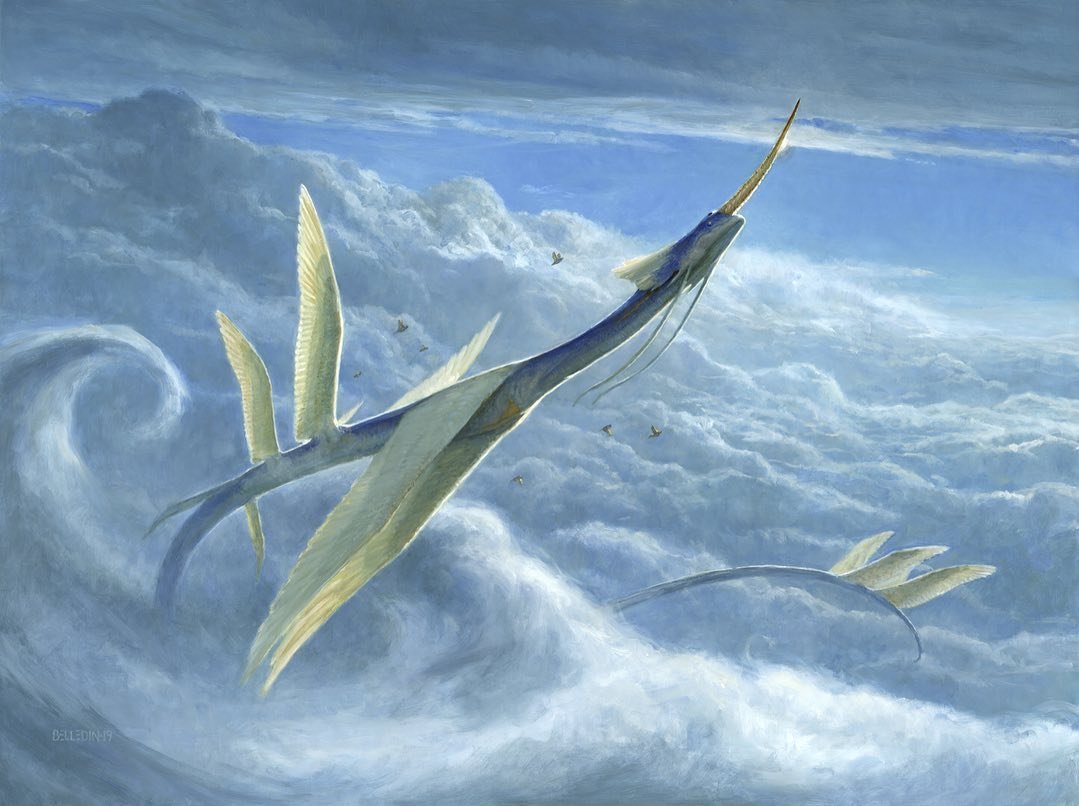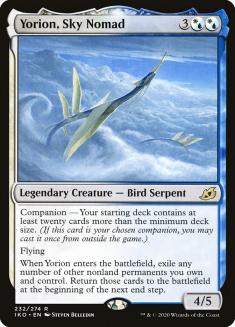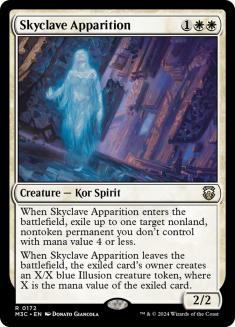The first cracks in the veneer of our shiny new format have started to appear. That’s not to say the format is ruined, or even less than great. It’s just that it was a little presumptuous of us to try to play Magic like it was 2015 when one of 2020’s greatest monsters was still soaring above the battlefield.
Yorion, Sky Nomad is 2020 Magic incarnate. It is patently acceptable as a creature, while also being a source of repetitive card advantage, a self-contained engine, a mana producer, a lifegain bot, a removal spell, and about 100 other functions. It asks much more of you than something like Omnath, Locus of Creation when it comes to deckbuilding. However, the cards Yorion is currently asking you to play are among the best in the format. It’s not a deckbuilding restriction if you were going to do it anyway. In particular, Skyclave Apparition is the best removal spell in Standard (and maybe Pioneer, Historic, Modern, and Legacy too).
My exploration of Yorion began in the middle of last week. Convinced that purveyors of fair Magic were deluding themselves, I was focused on finding the best engine in the format. Felidar Retreat was my starting point, and I was finding some decent results with decks designed to maximize the card.
Creatures (7)
Planeswalkers (4)
Lands (20)
Spells (49)

Creatures (19)
Lands (4)
Spells (37)
- 5 Forest
- 1 Plains
- 4 Mountain
- 4 Cultivate
- 3 Bala Ged Recovery
- 4 Spikefield Hazard
- 4 Shatterskull Smashing
- 4 Turntimber Symbiosis
- 3 Nahiri's Lithoforming
- 4 Felidar Retreat
- 1 Thundering Rebuke
Sideboard

Creatures (23)
- 4 Lotus Cobra
- 2 Dryad of the Ilysian Grove
- 2 Murasa Rootgrazer
- 4 Tangled Florahedron
- 1 Yasharn, Implacable Earth
- 4 Scute Swarm
- 4 Kazandu Mammoth
- 2 Ancient Greenwarden
Lands (7)
Spells (30)
- 3 Forest
- 6 Plains
- 4 Cultivate
- 4 Glass Casket
- 1 Elspeth Conquers Death
- 2 Bala Ged Recovery
- 3 Emeria's Call
- 1 Roiling Regrowth
- 2 Turntimber Symbiosis
- 4 Felidar Retreat
Sideboard

Ultimately, these felt too oblivious to what my opponents were doing. Decks like Dimir Rogues easily disrupted my plans, while decks like Golgari Adventures would just kill me before I did my relevant stuff. I needed an engine that could control the battlefield. Given my history, you won’t be shocked to hear I turned to Doom Foretold.
Creatures (14)
Lands (18)
Spells (28)

Doom Foretold gave me game against the problematic permanents that were outvaluing me elsewhere, and Mythos of Nethroi felt like the catch-all removal spell I had been lacking. However, I was still occasionally getting outscaled in very long games against control decks, usually by Yorion and Omen of the Sea.
I wondered if I had been beaten to the punch, and the outer limits of the format had already been found. However, my first games with Azorius “Blink”-style decks left me feeling underwhelmed. I ran out of gas far more often than I expected and it felt like I was only winning games where I naturally drew a maindeck Yorion and was able to start an early snowball. Otherwise, the inherent inconsistency in my deck would manifest across a bunch of turns. My deck was Skyclave Apparition, Dream Trawler, Yorion, and a bunch of mediocre filler.
The premise was good, but the execution felt lacking. Thankfully, I know a guy who’s rather good at tuning decks.
Creatures (15)
Lands (10)
Spells (35)

60 cards, four maindeck Yorion was a revelation. More on that in a moment. Despite this breakthrough, there were still issues. The deck felt extremely mopey when it drew one or no copies of Omen of the Sea. Yorion just wasn’t generating enough value to keep the snowball going in these scenarios.
You also had to play your games entirely on-curve. After a solid year of Simic nonsense, my tolerance for a deck that doesn’t cheat on mana has decreased dramatically. While I was winning a bunch, most of those wins came on the back on Dream Trawler — a card my opponents had apparently forgotten about since no one had any answers. I was convinced we could do better and make sure Yorion would get its due as the new best card in Zendikar Rising Standard.
Mission accomplished.
Creatures (25)
- 4 Gilded Goose
- 4 Wicked Wolf
- 2 Charming Prince
- 1 Kogla, the Titan Ape
- 4 Yorion, Sky Nomad
- 4 Llanowar Visionary
- 4 Skyclave Apparition
- 2 Tangled Florahedron
Lands (18)
Spells (17)

Creatures (24)
- 4 Gilded Goose
- 4 Wicked Wolf
- 1 Charming Prince
- 1 Kogla, the Titan Ape
- 4 Yorion, Sky Nomad
- 4 Llanowar Visionary
- 4 Skyclave Apparition
- 2 Tangled Florahedron
Planeswalkers (2)
Lands (20)
Spells (14)

While existing Mono-Green Food decks failed to impress me, there’s no question that the core engine is among the most powerful remaining in Standard. Wicked Wolf was initially giving me fits, causing me to dramatically adjust sideboards and maindecks to include things like Epic Downfall.
That was before it got to team up with Yorion. With Yorion in tow, the combination of Elspeth Conquers Death, Skyclave Apparition, and Wicked Wolf can control any battlefield. Add a Charming Prince to the mix and this control can become recursive. A mix of Trail of Crumbs; The Great Henge; and Vivien, Monsters’ Advocate mean you’re more likely to draw your deck than run out of things to do. You play ahead of curve with Gilded Goose and Llanowar Visionary. And you set up the soon-to-be-classic Charming Prince / Kogla, the Titan Ape combo.
You need to play this deck exactly one time to understand that there is something special here. Apparently, Ondrej Strasky agreed, as less than twelve hours after I posted my list to Twitter, he was taking 73 of 75 cards through nine undefeated rounds in his Saturday Tournament.
I think much of the deck speaks for itself, but the thing which will be most hotly contested in the coming days is whether you should be playing 80 cards and a companion Yorion. If this were Twitter, I’d make some bombastic statement about how anyone playing 80 cards is clearly wrong and should be charged with deck malpractice. The actual, non-hot version of my take is that I’m about 55% sure that 60-card Yorion decks are generally better across all archetypes, and about 70% sure that Selesnya Blink benefits from having 60 cards rather than 80.
Card quality across 80 card decks is not uniform, no matter how much we want to sell ourselves on the idea. This is a five-set Standard with loads of cards banned. Throne of Eldraine certainly does a lot to up average card quality, but every deckbuilder who has spent time working in this format knows that there are some holes at various spots on the curve.
Even in spots where card quality is close, ratios get messed up. I don’t want to be as likely to draw Omen of the Sun as I am to draw Skyclave Apparition. There’s a reason one is a two-of, and one is a four-of. In most 80-card decks, we tend to expand the mediocre filler to unacceptably high numbers. It all leads to a decreased focus in gameplan that is hard to trace back to deck expansion in the games where it punishes you.
Speaking of punishing, have you ever cast a Turn 4 Yorion that generates a bunch of value? Selesnya Blink has, and there’s no better feeling. Yorion decks are about snowballing, and the sooner that snowball starts, the earlier your deck reaches its apex of power. If you add three mana onto the cost of Yorion, you’ve either sacrificed a turn of development or delayed the appearance of the first Yorion.
Standard isn’t about casting a good Yorion. It’s about casting as many Yorions as you possibly can. Playing 60 cards with four Yorions means more average Yorion opportunities per game. I think. I don’t do math. This is where that 55% surety kicks in. I just know that, on feel, the 60-card decks feel far more likely to snowball to me. Even if a companion Yorion does a better job of allowing your first cast, it’s not the first Yorion that wins the game.
In Selesnya Blink specifically, there’s a compact engine that relies on a parasitic mechanic for empowerment. There are two ways to produce Food in this deck — Gilded Goose and Trail of Crumbs. The other options to make Food in the format are not remotely close on power level. Because your deck operates at such higher efficiency with reliable access to Food, and because the presence of Food tends to create more Food, you’re highly incentivized to compact your deck.
You’d think with a successful brew under my belt I’d be spending my time maximizing and championing it right now, but that’s just not how engage with Magic these days. The absence of meaningful Organized Play means I don’t feel any real incentive to practice or maximize my ability with a deck, so as soon as it became clear that this deck was going to be part of the metagame, I started working on both exploiting and altering it, often in the same list. Let’s start with the exploits.
Creatures (7)
Planeswalkers (4)
Lands (16)
Spells (33)
- 6 Plains
- 1 Mountain
- 2 Island
- 2 Glass Casket
- 4 Omen of the Sea
- 4 The Birth of Meletis
- 4 Omen of the Sun
- 1 Elspeth Conquers Death
- 3 Shatter the Sky
- 3 Shark Typhoon
- 3 Mazemind Tome
Sideboard

One of the big weaknesses that became apparent after a couple of days of Selesnya Blink was a lack of good options to control Dream Trawler. My first list was banking on Run Afoul as a narrow out, but it was too hard to reliably find and Dream Trawler was still too small of a portion of the metagame to justify playing Run Afoul in large numbers. I think using Sorcerous Spyglass makes more sense, but still, Dream Trawler is a strong option against Selesnya Blink and the format in general right now. Jean-Emmanuel Depraz has been reaping big dividends at the top of the Mythic ladder maximizing Dream Trawler alongside Lukka, Coppercoat Outcast.
Creatures (4)
Planeswalkers (2)
Lands (33)
Spells (41)
- 2 Negate
- 2 Essence Scatter
- 2 Mystical Dispute
- 4 Glass Casket
- 4 Omen of the Sea
- 4 The Birth of Meletis
- 4 Omen of the Sun
- 4 Elspeth Conquers Death
- 4 Shark Typhoon
- 4 Mazemind Tome
- 4 Transmogrify
- 3 Valakut Awakening
Sideboard

I really liked this list, but I think it is all-in on the idea that opponents aren’t showing proper respect to Dream Trawler. Once they do, the deck will benefit from a broader focus and a commitment to making Yorion a real card in your deck. Playing Lukka as a card that can potentially snag multiple creatures is a new look, but Yorion is so powerful and so good in multiples that I think you can mitigate the uncertainty that a Lukka minus now creates. In return you become a deck with two cohabitating A-plans in Dream Trawler and Yorion, and a solid B-plan in Shark token beatdown, all while keeping your average card quality through the roof. Lukka benefits massively from the absence of instant-speed removal in Selesnya Blink. It’s one of the few decks that does a great job sidestepping Skyclave Apparition.
I like that sideboard configurations let us cut Lukka and become just a Jeskai Midrange deck against things like Mono-Red. I also considered just playing Skyclave Apparition maindeck, on the theory that it also tracks as a worthy Lukka hit and provides adequate creature density to make the plus ability on Lukka relevant. Maybe that’s a bridge too far, but you do feel the lack of Skyclave Apparition in the maindeck. Things like Trail of Crumbs can actually leave opponents with ways to keep pace with your Dream Trawlers. I should know. I’ve done it often enough on the Selesnya Blink side.
Creatures (18)
Planeswalkers (4)
Lands (14)
Spells (24)
- 6 Forest
- 2 Mountain
- 2 Island
- 4 Omen of the Hunt
- 4 Omen of the Sea
- 4 Genesis Ultimatum
- 2 Shatterskull Smashing
Sideboard

The other glaring weakness of Selesnya Blink is a lack of countermagic. If an opponent knows they can spend as much mana as they want without being punished, they can go over the top of even Yorion loops. The best way to do so is clearly Ugin, the Spirit Dragon. Again, I’ve made concessions to this card with the new addition of Sorcerous Spyglass, but a huge Genesis Ultimatum will still be a knockout in a bunch of spots. I think this particular deck is extremely narrow and doesn’t stand up to any disruption. Still, if you need to punish Selesnya Blink specifically, it’s good to know there are viable options.
Creatures (7)
Planeswalkers (4)
Lands (12)
Spells (37)

I don’t think it’s fair to lump this in with the decks that are trying to exploit Selesnya Blink. This is just a bit of a half measure, looking to benefit from the Yorion package without leaving itself super-vulnerable to the types of countermeasures I expect to crop up in the next few days. I’m pretty low on this particular list as built, but using Phylath, World Sculptor and Yorion in conjunction with Omen of the Hunt and Felidar Retreat is just too cute to ignore.
Beyond building Yorion decks to try to target Selesnya Blink, I also explored some options that tried to really cut the deck down to its core essence while getting ahead of oncoming metagame adaptations.
Creatures (23)
- 4 Arcanist's Owl
- 3 Charming Prince
- 3 Daxos, Blessed by the Sun
- 3 Heliod, Sun-Crowned
- 2 Alseid of Life's Bounty
- 4 Yorion, Sky Nomad
- 4 Skyclave Apparition
Lands (3)
Spells (34)

This Mono-White Blink list went all-in on the Yorion / Charming Prince loops, and brought along a bunch of ways to generate value while doing so. Arcanist Owl is among the best things you could ever blink with a Yorion, and once it’s here, we’ve got more than enough devotion to power up Heliod, Sun-Crowned as an attacker. It’s a shame that Skyclave Apparition is playing both teams here by being one of the biggest incentives to put Heliod in your deck and also being an exceptionally good answer to the card.
This deck can go off just as hard as Selesnya Blink, but in a different way. Being able to pump evasive bodies means you have a real shot at closing games in combat rather than just by sheer card quantity. Emeria’s Call deserves props for being very low-cost for our manabase, and a card that generates a token that is immune to both Skyclave Apparition and Elspeth Conquers Death. This deck is better than you’d expect a mono-white deck to be; it just needs a reason to justify its existence. If something like Mono-Red becomes very popular, maybe this is the deck that will rise up to keep it in check.
Creatures (26)
- 4 Gilded Goose
- 4 Wicked Wolf
- 4 Yorion, Sky Nomad
- 4 Llanowar Visionary
- 3 Barrin, Tolarian Archmage
- 2 Tangled Florahedron
- 4 Glasspool Mimic
- 1 Master of Winds
Lands (6)
Spells (28)
- 8 Forest
- 3 Island
- 4 Trail of Crumbs
- 2 Omen of the Hunt
- 4 Omen of the Sea
- 3 Thassa's Intervention
- 1 Sea Gate Restoration
- 3 Turntimber Symbiosis
Sideboard

This particular list supposes that the most important essence of Selesnya Blink is the mana advantage it was able to accrue. It sort of tracks. Given enough resources and time, you move things through enough zones and generate enough card advantage that there isn’t really a problem you can’t deal with. We also get to pick up critical maindeck countermagic in the form of Thassa’s Intervention, with reinforcements in the sideboard. This deck actually has something resembling aggressive draws, with Barrin, Tolarian Archmage into Wicked Wolf into Yorion keeping opponents entirely off the battlefield.
Obviously, this deck has some problems with resolved permanents like Trail of Crumbs in Game 1s. The hope is your mana and your Omen of the Seas just let you do a better job of assembling the best version of your engine. It’s been powerful, but I really do miss Skyclave Apparition here.
Blink And You Might Miss It
Building these Yorion decks has been a blast. In fact, all of my post-ban deckbuilding has felt extremely refreshing. There’s space to explore powerful, novel ideas again. However, that space is rapidly shrinking. Yorion, Ugin, and even Skyclave Apparition are starting to put some clamps on the format and limit what is actually viable. I’m hopeful that this metagame will start to churn, and that the Yorion decks face some punishment over the next week. If people are slow to adapt though, you may as well take your free wins while they are there.




